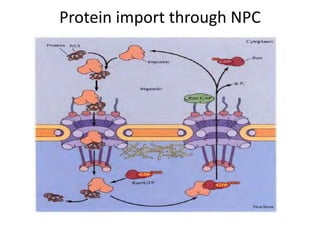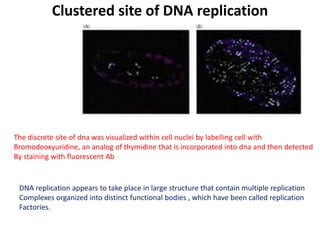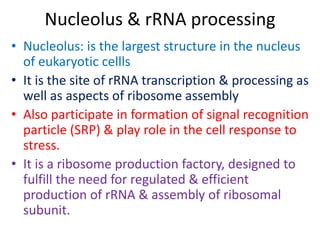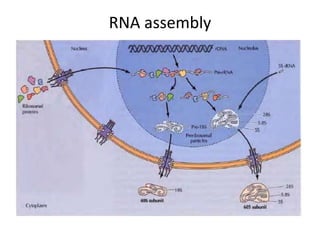Nucleus sk
- 1. NUCLEUS • Nucleus is membrane enclosed organelle found in eukaryotic cell. • Eukaryotes usually have a single nucleus, but a few cell types, such as mammalian RBC have no nuclei, and few others including osteoclasts have many. • By housing the cell genome, nucleus serve both as the repository of genetic information and as the cell control center.
- 2. • DNA replication, transcription , rna processing all take place within the nucleus, with only final stage of gene expression(translation) localized to cytoplasm. • The presence of nucleus thus allows gene expression to be regulated by post- transcriptional mechanism, such as alternative splicing.
- 3. NUCLEAR ENVELOPE An electron micrograph of a nucleus. The inner and outer nuclear membrane are joined at nuclear pore complexs(arrows).
- 4. Illustrate the continuity of outer nuclaer membrane with endoplasmic reticulum
- 5. Schematic of the nuclear envelope. the inner nuclear membrane is lined by the nuclear lamina, which serves as attachment site for chromatin
- 6. The electron micrograph show nuclear pore: many nuclear pore are visible in this freeze Preparation of the nuclear envelope
- 7. Nuclear lamina is a meshwork of filaments underlaying the inner nuclear membrane And extending into the interior of the nucleus
- 9. Model of lamin assembly The lamin polypetide form dimer in which the central alpha helical region of two polypetide chain are wound around each other. Further assembly may involve the head-to-tail association of dimer to form linear polyper and the side by side association of polyper to form higher order structure
- 10. The inner nuclear membrane contain several integral proteins,such as EMERIN and the LAMINA B Receptor(LBR) that interact with nuclear lamins. The lamins also interact with Chromatin.
- 11. Nuclear pore complex(NPC) • Transport of proteins from the cytoplasm into the nucleus &movement of macromolecules, including mRNA, tRNA, and ribosomal subunit out of the nucleus occur through NPC. • Mass of pore structure is 125 million Da which is about 30 times larger than a ribosome • NPC is made up of multiple copies of 30 different proteins called nucleoporin.
- 12. • It is roughly octagonal, membrane embedded structure from which approx.100nm long filament extend into the nucleoplasm. The distal end of these filament are joined by the terminal ring, forming a structure called nuclear basket. • The membrane embedded portion of NPC is also attached directly to nuclear lamins
- 14. NPC; The complex consist of an assembly of eight spoke attached to the rings on the Cytoplasmic and nuclear side of the nuclear envelope. The spoke-ring assembly surround a Central channel. Cytoplasmic filaments extended from the cytoplasmic ring and filaments Forming the nuclear basket extend from the nuclear ring.
- 15. Molecular traffic through NPC Small molecules and some proteins with molecular mass less than approx.20-40 Kd pass freely through pore in either direction. In contrast, macromolecules (proteins and RNAs of large size)are transported by a selective, energy dependent mechanism.
- 16. Selective transport of proteins to & from the nucleus • Several millions macromolecules selectively pass b/w the nucleus &the cytoplasm every minute. • Importin : from cytoplasm to nucleus • Import-in transport protein (histones, transcription factor, DNA pol. ,RNA pol. , splicing factors & many others) containing Nuclear localization signal (NLS) into the nucleus.
- 17. • NLS that are recognized by transport receptor & direct the transport of protein through NPC. • NLS first discovered in simian virus 40 (SV40) T-antigen, a virus encoded protein that initiates viral DNA replication in infected cell. • NLS rich in seven basic AA that are Pro-Lys-Lys- Lys-Arg-Lys-val
- 18. • Often, however, the AA that form the NLS are close together but not immediately adjacent to each other i.e. Nucleoplasmin (a protein involved in chromatin assembly) consist of two parts: a Lys-Arg pair followed by four Lys located ten AA farther downstream(BIPARTITE
- 19. NLS are recognized by proteins that function as nuclear transport receptor Most are members of the karyopherin protein family & function either as Importins or exportins
- 20. Movement of molecule through the nuclear pore is regulated by a protein called Ran • Ran is small GTP binding protein whose conformation & activity are regulated by GTP binding & hydrolysis. • For Ran, enzyme GAP ( GTPase activating protein) are present in Cytosol that hydrolyise the GTP to GDP and enzyme GEF( Guanine nucleotide exchange factor) that stimulate the exchange of GDP for GTP are present at nuclear side.
- 22. • Like import proteins have NLS , Export protein (from nucleus to cytosol) have NES ( nuclear export signal). • The NLS of importein protein interact with importein which guide it through NPC. • Impotein is heterodimer of alpha & beta subunit. • Alpha- interact with cargo protein & beta- interact with protein in the nuclear pore to shuttle the cargo protein through it. • Protein in pore is called FG Nucleoprotein which line the channel of NPC,basket, cyto. Filaments.
- 23. Protein import through NPC
- 25. EXPORT • In export :- proteins, tRNA, & ribosomal subunit from the nucleus to the cytoplasm. • NES( Nuclear export signal) that stimulate protein to be export from the nucleus to cytoplasm. • Three diff. classes of NES:- 1) a leucine rich sequence found in PKI ( inhibitor of protein kinase A) & in protein HIV. As well as two diff. sequence identified in two diff. Heterogenous ribonucleoprotein particle
- 26. • Exportin or nuclear export receptor in the nucleus called Exportin-1 • Expotin-1 first form complex with Ran-GTP causes a conformational change in it that increase its affinity for NES , so that a trimolecular cargo complex is formed • Like importin, exportin interact transiently with FG-repeats in FG nucleoporin & diffuse through NPC
- 28. Complex b/w cargo protein bearing NES, Exportin, & Ran-GTP form in nucleus. Following Transport through NPC, Ran-GAP stimulate the hydrolysis of the cargo protein & exprtin into The cytoplasm. Exportin is then transported back to nucleus.
- 29. Regulation of nuclear protein import
- 30. Transport of SnRNAs b/w nucleus & cytoplasm Transport receptor protein that bind to the 5’cap of SnRNA appear to be involved in the Export of the snRNA to the cytoplasm. In contrast, sequence present on snRNP protein are Responsible for the transport of snRNPs from the cytoplasm to the nucleus. Function: splicing of other RNA
- 31. Internal organization of the nucleus • Nucleus has an internal structure that organizes the genetic material & localize nuclear function. • Lamins serve as sites of chromatin attachment & organize other proteins into functional nuclear bodies. • Chromatin organized into large loops of DNA & specific region of these loops are bound to lamin matrix by lamin binding protein in the chromatin. • Many other protein have lamin dependent complexes that has role in dna repair, gene regulation, chromatin organization & signal transduction.
- 32. Chromosomes & high order chromatin structure • Chromatin bcm highly condensed during mitosis to form the compact metaphase chromosome that are distributed to daughter nuclei. • During interphase :- • Heterochromatin: highly condensed & transcriptionally inactive • Euchromatin: decondensed & active •
- 33. Heterochromatin Constitutive • Same region in dna sequence of all cell that are generally not transcribed such as satellite sequence present at centromere --- 1,9,16,19 & Y Chromosome facultative Different region in dna sequence of different cell that are not transcribed. i.e. x-chromosome in female, in one cell one is inactive & other cell is another type
- 34. Chromatin distribution • Each chromosome occupies a different territory, with centromere & telomere attached to opposite sides of the nuclear envelope. Organization of drosophila chromosomes Five chromosome arm in different color
- 35. A model of chromosome organization The chromosome occupy discrete territories Separated by interchromosomal domain in Which RNA processing and transport are Thought to occur
- 36. Clustered site of DNA replication The discrete site of dna was visualized within cell nuclei by labelling cell with Bromodeoxyuridine, an analog of thymidine that is incorporated into dna and then detected By staining with fluorescent Ab DNA replication appears to take place in large structure that contain multiple replication Complexes organized into distinct functional bodies , which have been called replication Factories.
- 37. Localization of splicing components While actively transcribed genes appear to be Distributed throughout the nucleus, components of The mRNA splicing machinery are concentrated in Discrete nuclear bodies termed nuclear speckles.
- 38. Nuclei contain PML & cajal bodies • PML (nuclear dots or nuclear bodies or promyelocytic leukemia protein) are known to interact with chromatin & are the site of accumulation of transcription factors & chromatin modifying proteins (such as histone deacetylases). • Cajal bodies contain protein coilin & contain high concentration of splicing small nuclear- ribonucleoprotein(snRNP) possibly indicating that they function to modify RNA after it has been transcribed from DNA.
- 40. Nucleolus & rRNA processing • Nucleolus: is the largest structure in the nucleus of eukaryotic cellls • It is the site of rRNA transcription & processing as well as aspects of ribosome assembly • Also participate in formation of signal recognition particle (SRP) & play role in the cell response to stress. • It is a ribosome production factory, designed to fulfill the need for regulated & efficient production of rRNA & assembly of ribosomal subunit.
- 42. Ribosomal RNA gene • The nucleolus, which is not surrounded by membrane is associated with the chromosomal regions that contain the genes for the 5.8s,18s,& 28s rRNA. These are transcribe by RNA pol. 1, yielding a 45S ribosomal precursor rna. • The 45S pre-rRNA is processed to the 18s of the 40s of small & to the 5.8s, 28s of 60s large ribosomal subunit. • Transcription of 5s rRNA, which is also found in the 60s, takes place outside the nucleolus in higher eukaryotes & is catalyzed by RNA pol.3
- 43. The genes for 5.8S, 18S , & 28S rRNA are clustered in tandem arrays on five different Chromosomes 13,14,15,21,&22. the 5s rRNA genes are present in single tandem array on Chromosome 1. The rRNA genes are organized in tandem arrays, separated by nontranscribed Spacer DNA
- 44. Transcription & processing of rRNA The 45S pre-rRNA transcript contains external transcribed spacer(ETS) at both end and Internal transcribed spacer(ITS) b/w the sequence of 18s,5.8s,28s rRNAs. These pre-rRNA is Processed via a series of cleavage to yield the mature rRNA species.
- 45. • The processing of pre-rRNA requires the action of both proteins and RNA that are localized to the nucleolus. • The small nucleolar RNAs(snoRNAs) function in pre-rRNA processing. • snoRNA+Protein=snoRNP(Small nucleolar ribonucleoprotein) function as: • 1)Form splicesome complex for splicing. • 2)methylation of specific ribose residue. • 3)formation of pseudouridines by converting uridine
- 46. Role of snoRNAs in base modification
- 47. RNA assembly
- 48. Ribosome assembly • Ribosome protein are imported to the nucleolus from the cytoplasm & begin to assemble on pre-rRNA prior to its cleavage. As the pre-rRNA is processed, additional ribosomal proteins & the 5S rRNA(which is synthesized elsewhere in the nucleus) assemble to form preribosomal particles. • The final step of maturation follow the export of preribosomal particles to the cytoplasm, yielding the 40S & 60S ribosomal subunits.
















































